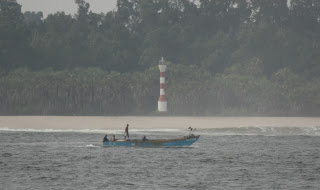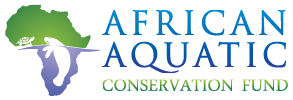Whale Days
Manatee work in Angola is part of a larger project here that also includes cetacean and sea turtle research. On this trip Tim and our other collaborator Sal (who arrived last Tuesday) are doing cetacean work, and since most of my background with whales and dolphins has been stranding work (dead and injured), it’s been nice to have some opportunities to see happy, healthy whales that are not in distress. (How do I know the whales are happy? Most of what we see here is mating activity, so I’m assuming this makes them happy!)
Going out in the ocean also gives me the opportunity to see the nearshore and offshore habitat. It’s unknown how frequently African manatees go out into the sea; clearly they did at some point in order to disperse along most of the west coast of Africa, but other than reports of manatees seen traveling offshore in Ghana (Buddy Powell, personal communication) and in the Bijalos Archipelago off Guinea-Bissau, there seem to be no other reports of manatees sighted in the ocean (if anyone knows of any others, I’d be very interested to hear about them). I’d expect them to stay close to shore since there’s very little seagrass (and none where there’s rough surf) so they would primarily use the ocean to travel from one river or lagoon system to another. In both Angola and Gabon the surf is almost always intense, so even if they’re there they may not be seen. Fishermen in Angola laugh when asked if they ever see manatees in the ocean- they assume I’m making a joke.

 Last week Tim and I went out to do a dolphin survey just off the Sereia peninsula. We started transects down the peninsula, but after we rounded a point on the coast the swell became too strong, so the chance of being able to sight dolphins was severely reduced and we had to stop the survey. Luckily we then spotted some humpback whales close to shore and were able to document them. Tim IDs these whales primarily through photos of markings on dorsal fins and flukes, and it’ll be very cool if he can match any sighted here to animals recorded in other parts of the Gulf of Guinea. Or if there’s no previous record, he’ll be able to create a new one, which also gives great information about whales here, where almost no one has studied marine mammals before.
Last week Tim and I went out to do a dolphin survey just off the Sereia peninsula. We started transects down the peninsula, but after we rounded a point on the coast the swell became too strong, so the chance of being able to sight dolphins was severely reduced and we had to stop the survey. Luckily we then spotted some humpback whales close to shore and were able to document them. Tim IDs these whales primarily through photos of markings on dorsal fins and flukes, and it’ll be very cool if he can match any sighted here to animals recorded in other parts of the Gulf of Guinea. Or if there’s no previous record, he’ll be able to create a new one, which also gives great information about whales here, where almost no one has studied marine mammals before. Two humpbacks we were able to photograph for about an hour.
Two humpbacks we were able to photograph for about an hour. You can see how close we were to the peninsula in this shot.
You can see how close we were to the peninsula in this shot.
